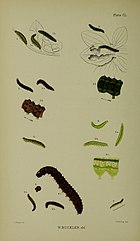Conservation Status
provided by University of Alberta Museums
Never common, but probably of no concern.
- license
- cc-by-nc
- copyright
- University of Alberta Museums
Cyclicity
provided by University of Alberta Museums
June to mid July.
- license
- cc-by-nc
- copyright
- University of Alberta Museums
Distribution
provided by University of Alberta Museums
Holarctic, the North American species being Anania funebris glomeralis (Wlk.). Across Canada, north to Fort Smith and Fort Simpson in the Northwest Territories, south to North Carolina and Coloradi (Munroe 1976). Listed in Alberta from Areas 6-8, 10, 18 and 20 by Bowman (1951) as Pyrausta funebris.
- license
- cc-by-nc
- copyright
- University of Alberta Museums
General Description
provided by University of Alberta Museums
An easily recognized, diurnal, black and white micromoth. It has a wingspan of 20-21 mm, two large, white spots on each wing and an abdomen with white stripes. It also has a small white patch above the large, white patches on the forewings. Quite similar to the macromoth Alypia langtoni, The Eight-spotted Forester, which, however, is larger (wingspan 30 mm), has larger yellow patches (tegulae) on the thorax beside the wings, lacks the small patch on the forewings and the white stripes on the abdomen, and whose larvae feed on Fireweed (Epilobium angustifolium).
- license
- cc-by-nc
- copyright
- University of Alberta Museums
Habitat
provided by University of Alberta Museums
Clearings in wooded areas, especially those with Populus tremuloides.
- license
- cc-by-nc
- copyright
- University of Alberta Museums
Life Cycle
provided by University of Alberta Museums
Larva light yellow-green, with yellowish head; living on the underside of the basal leaves of Solidago (Forbes 1923). Adults are diurnal.
- license
- cc-by-nc
- copyright
- University of Alberta Museums
Trophic Strategy
provided by University of Alberta Museums
Goldenrod (Solidago) (Forbes 1923).
- license
- cc-by-nc
- copyright
- University of Alberta Museums
Anania funebris
provided by wikipedia EN
Anania funebris, the White Spotted Sable, is a species of diurnal dayflying moth of the family Crambidae. It is found in many countries such as Europe, Siberia, the Northern parts of the Far East and North America.
Description
The wingspan is 20–23 mm (0.79-0.92 in). The forewings are black; a large round white subdorsal spot before middle, and a second in disc beyond middle; sometimes a white dot above first; cilia white towards tips. Hindwings as forewings, but without the white dot. The larva is ochreous-whitish; dorsal line deep green; subdorsal and lateral green; spiracular whitish-green; dots green; head whitish-brown.[1]

Figs 4, 4a, 4b larvae after final moult 4c enlargement of two segments 4 under a lowermost leaf of
Solidago virgaurea.
Behavior
The adults have a tendency to quickly hide behind leaves.[2]
The moth flies from May to September, June and July being the most active in their flight season.
Diet
The larvae feed on leaves of Goldenrod (Solidago) such as Solidago virgaurea. It occasionally feeds on Dyer's Greenweed (Genista tinctoria).[3]
References

- license
- cc-by-sa-3.0
- copyright
- Wikipedia authors and editors
Anania funebris: Brief Summary
provided by wikipedia EN
Anania funebris, the White Spotted Sable, is a species of diurnal dayflying moth of the family Crambidae. It is found in many countries such as Europe, Siberia, the Northern parts of the Far East and North America.
- license
- cc-by-sa-3.0
- copyright
- Wikipedia authors and editors

